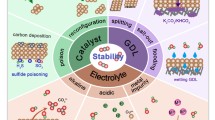Abstract
Pursuing the studies of the effect of solution flow rate and direction on filling of a porous electrode with deposited metals, the peculiarities of individual and joint deposition of metals are studied for the rear solution delivery. In the rear delivery mode, the nonmonotonic dependence of the final mass of the cathodic deposit m f on the solution flow rate m v with the maximum at middle flow rates is observed to hold. The main differences from the frontal delivery mode are the much higher mass values in the maximum m f, max (1.5–3.5-fold higher) and the lower concomitant flow rates m v, max (0.05–1 cm3/s). Moreover, the highest mass gains and rate shifts correspond to the lower cathodic polarization values. These differences are associated with the opposite orientation of the polarization and metal-concentration profiles inside the PE, which is typical of the rear delivery, and also with the gradual shift of the PE critical section from the frontal to rear plane as the solution flow rate decreases. For the rear delivery, the m f, max value observed in the direct-flow mode turns out to be even a little higher as compared with the circulation mode. This makes the direct-flow mode of electrolysis in the middle range of flow rates the most efficient condition for the metal codeposition into a PE at the rear delivery. Experimental data on the individual and joint deposition of silver and copper on carbon felt VINN-250 from alkaline thiosulfate solutions at the rear delivery and different solution rates qualitatively agrees with the model calculations for a PE with the same specific surface.
Similar content being viewed by others
References
Maslii, A.I., Poddubnyi, N.P., Medvedev, A.Zh., and Karunina, O.V., Russ. J. Electrochem., 2014, vol. 50, no. 10, p.1011.
Masliy, A.I., Poddubny, N.P., Medvedev, A.Zh., Belobaba, A.G., and Bokhonov, B.B., J. Electroanal. Chem., 2012, vol. 664, p. 126.
Maslii, A.I., Poddubnyi, N.P., and Medvedev, A.Zh., Russ. J. Electrochem., 2011, vol. 47, p. 1016.
Maslii, A.I., Poddubnyi, N.P., and Medvedev, A.Zh., Russ. J. Electrochem., 2006, vol. 42, p. 157.
Varentsov, V.K., Zherebilov, A.F., and Malei, M.D., Izv. Sib. Otd. Akad. Nauk SSSR, Ser. Khim. Nauk, 1984, no. 17(6), p. 120.
Author information
Authors and Affiliations
Corresponding author
Additional information
Original Russian Text © A.I. Maslii, N.P. Poddubnyi, A.Zh. Medvedev, O.V. Karunina, 2014, published in Elektrokhimiya, 2014, Vol. 50, No. 10, pp. 1021–1029.
Rights and permissions
About this article
Cite this article
Maslii, A.I., Poddubnyi, N.P., Medvedev, A.Z. et al. The effect of the solution flow rate on the final mass of metals deposited into a porous electrode at individual and joint deposition. Rear delivery of solution. Russ J Electrochem 50, 918–925 (2014). https://doi.org/10.1134/S1023193514100073
Received:
Published:
Issue Date:
DOI: https://doi.org/10.1134/S1023193514100073




